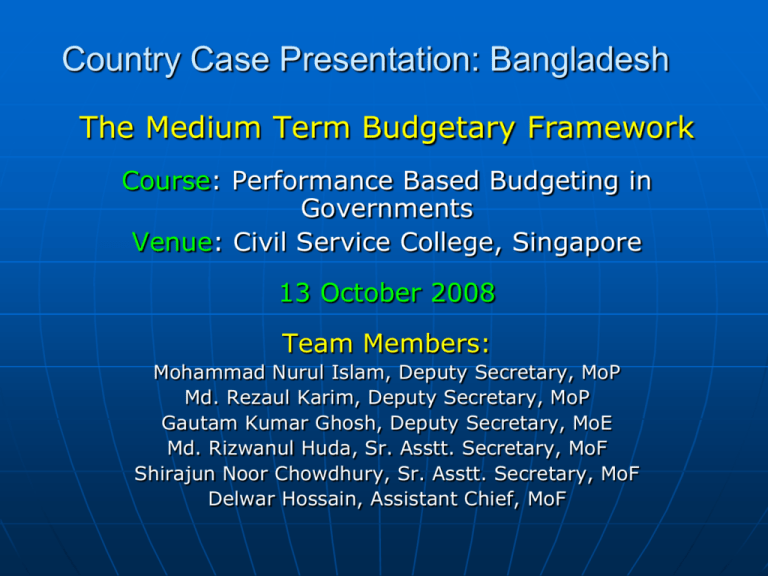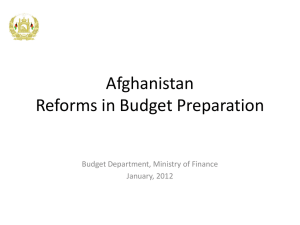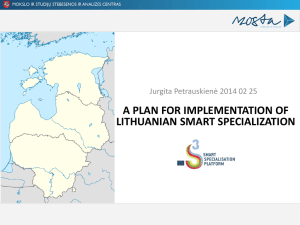Document
advertisement

Country Case Presentation: Bangladesh The Medium Term Budgetary Framework Course: Performance Based Budgeting in Governments Venue: Civil Service College, Singapore 13 October 2008 Team Members: Mohammad Nurul Islam, Deputy Secretary, MoP Md. Rezaul Karim, Deputy Secretary, MoP Gautam Kumar Ghosh, Deputy Secretary, MoE Md. Rizwanul Huda, Sr. Asstt. Secretary, MoF Shirajun Noor Chowdhury, Sr. Asstt. Secretary, MoF Delwar Hossain, Assistant Chief, MoF The Economy & the Budget of Bangladesh Some Geographic, Social, and Economic Indicators: Capital: Area: Population: Population (annual growth rate): Density of Population (per Sq. Km.): Per capita national income: GDP growth at constant price: Agriculture as share of GDP: Export as share of GDP: literacy rate (age 7+): Dhaka 147,570 Sq. Km 140.60 million (2007) 1.41% 953 (2007) US $ 599 (2007) 6.2% 20.87% (2007) 18% (2007) 52.5 (2006) Life Expectancy: 64.5 (2007) People below the poverty line: 40% national, 43.8% rural, 28.4 urban (HIES 2005) Budget at a Glance (2008-09): Non-Development Expenditure: US $ 10.06 Billion Development Expenditure: US $ 4.22 Billion Total Expenditure: US $ 14.28 Billion Total Revenue as % of GDP: 11.17 Total Expenditure as % of GDP: 17.27 Budget Deficit as % of GDP: 6.1 Net External Financing as % of GDP: 2.4 Net Domestic Financing as % of GDP: 3.7 2 The key Differences between the MTBF and the Traditional Budget The MTBF integrates both recurrent and investment expenditure rather than the two traditional budgets of development and nondevelopment. Traditionally a budget has been formulated for 1 year - the MTBF introduces a multi-year time horizon for budget planning - in Bangladesh that is 3 years. MTBF brings together the policy planning and budgeting processes. Resource allocation is linked to the policies and priorities of the Ministry. The traditional budget approach is incremental i.e. a percentage added to last year’s allocation. The traditional budget focuses on inputs only. Under the medium term framework the output and outcome expected from the budget allocation is considered. Under MTBF line ministries are given enhanced authority to allocate funds according to their specific needs. 3 Background and Timeline of PFM Reforms in Bangladesh 1990 1989 – 1990 Committee on Reforms in Budgeting and Expenditure Control 1995 2000 1993 – 2002 Reforms in Budgeting and Expenditure Control Project 2005 2003 - 2009 Financial Management Reform Project 2010 2009 - ? PFM Vision Experience tells us that maintaining impetus for the reform process is key – minimise the “gaps” 4 MTBF - Background The 1st phase of public financial reforms in Bangladesh, which originated from the CORBEC report in 1989 focused on technical improvements, examples: Computerisation and consolidation of financial data; New classification of accounts; 5 MTBF - Background The 2nd phase of public financial reforms focused on improvements to resource management, through: • Macro modelling, debt management; • Strengthening the linkage between policy planning and budgeting; • Devolution of responsibility for planning and budgeting to the line ministries; • Increased focus on monitoring and evaluation both internal and external. 6 Operational Components of the Financial Management Reform Programme Component 1 Social performance auditing Entity based auditing Debt Management Component 2 Macro economic framework Systems based financial auditing Treasury Management Institutional support for the Comptroller and Auditor General Training Capacity Building Systems maintenance Institutional support for the planning and budgeting process Information Technology Gender poverty Computerisation of the accounting system Budget Call notice support Support to District & Upazilla Accounting Offices Component 4 Institutional support for the Controller General of Accounts and issues Budget Management Committees Internal audit Performance Monitoring Ministry Planning Functions 7 Component 3 MTBF The Main Features A medium term outlook to budget planning – 3 years Linking policy priorities to resource allocations – NSAPR to budget Emphasizing the efficient use of limited public resources 8 The Objectives of MTBF The Objectives of MTBF in Summary: Operationalising the NSAPR; Enhancing line ministries capacity to formulate policy and programmes; Delegating more responsibility for budget setting; Performance measurement; 9 Success Achieved: MTBF Approach Macro economic forecasting RESOURCES PRIORITIES ACTIVITIES OUTPUTS NSAPR/National Policy Documents OUTCOMES Ministry Objectives 10 Success Achieved: MTBF Approach (Cont.) Strategic phase Resource Allocation phase Budget Call Circular I Budget Call Circular II Issued October Issued February 11 The Strategic Phase Provide a direction for the ministry Inject a sense of purpose into the ministries activities Decide WHO we are, WHAT we do, and WHERE we are going Provide a 3 year projection of total aggregate budget allocation – development and non-development 12 The Strategic Phase Budget Call Circular I – Ministry Budget Framework (MBF) - Contents: • Mission Statement to reflect the management’s • • • • • • • vision of what the ministry seeks to do and become The medium term strategic objectives The key activities Key performance indicators Targets against which performance can be measured Prioritisation of the use of resources Assess the poverty and gender impact of the strategies Initial allocation of aggregate development and non-development resources for 3 years 13 Detailed Resource Allocation Phase Budget Call Circular II • The MBF (BCCI) will be evaluated by FD and PC. Based on this evaluation, and considering any changes in macro economic trends the ministry resources ceilings may be slightly revised, • Within the revised ceiling the ministry must undertake a detailed allocation of resources, • The resources are applied to achieve the targets and KPIs contained in the MBF 14 Budget Implementation and Monitoring Once the budget has been set the Ministry has an obligation to turn it into action; One key element of this is to compare actual performance against what was expected; This requires the regular production of performance reports for discussion at management level; Periodic Reports • ADP monthly review • CGA/CAO monthly financial information • Departmental performance information Annual Reports • Ministry Wide Accounting • Entity Wide Audit 15 NSAPR/National Policy Documents Ministry Objectives RESOURCES ACTIVITIES OUTPUTS OUTCOMES Performance Measurement ECONOMY EFFICIENCY EFFECTIVENESS 16 Who’s who in MTBF (Line Ministry) Secretary BMC Joint Sec./ Chief BWG Sr./ Asstt. Chief Sr. /Asstt. Sec - Consists of Addl.Secs/ Jt. Secs, Organizational Heads, Representatives of FD, PC, IMED & CAO - Budget Approval authority within Line Ministry - Guides the process - Acts as member secretary of BMC - Presides BWG -Consists of organizational representatives and representative from FD, PC - Assists BMC with necessary support for decision making Dy. Sec./Chief Budget Mgt. Branch -Leads the process as Principal Accounting Officer -Acts as president of BMC - Coordinates the process -Does the groundwork -Collects and compiles information -Drafts MBF with budget allocation 17 Budget Management Committee The Chairperson of the BMC – Secretary RESPONSIBILITIES: Managing the entire budget Revenue and Development of the ministry/division; Developing a strategic plan to guide budget management; Preparing a medium term budget within the Resource Ceiling; Monitoring the performance of the ministry in both financial and output terms; Preparing and publishing annual report(s) on the financial and non-financial performance of the ministry/division; 18 Working Groups and BMC Sub Committees Budget Working Group (BWG) • To assist the Budget Management Committee (BMC), • The BWG has specific terms of reference but it is not a decision making body. Key role is to prepare MTBF related reports for the BMC, • The chairman of the BWG is the Member Secretary of the BMC. 19 Time line for Budget Preparation under MTBF Process FD Initial Ceiling Final Ceiling LM BCCII April March Feb Jan Dec Nov Oct Budget Compilation and Approval Sep FD Aug Finalizing ADP July PC June FD May BCCI LM LM = Line Ministry PC = Planning Commission 20 FD = Finance Division MTBF Line Ministries Year 1 (2005-06): 4 Pilot Ministries • • • • Ministry Ministry Ministry Ministry of of of of Education Social Welfare Women and Children’s Affairs Agriculture Year 2 (2006-07): 6 additional Ministries • • • • • • Ministry of Primary and Mass Education Ministry of Health and Family Welfare Local Government Division Ministry of Fisheries and Livestock Ministry of Water Resources Ministry of Communications 21 MTBF Line Ministries Year 3 (2007-08): 4 additional Ministries • • • • Ministry of Science and ICT Rural Development and Cooperatives Division Ministry of Environment and Forest Ministry of Food and Disaster Management Year 4 (2008-09): 2 additional Ministries • Ministry of Shipping • Ministry of Land 22 Total Budget & the MTBF Ministries 23 Gaps in PFM Reform Involving senior officials in the MTBF process that is lack of ownership (what Finance Secretary is doing now by visiting line ministry with FD senior officers to motivate them in the process) Updating financial and administrative powers in line with MTBF process Insufficient training for MTBF related officials in the line ministry Absence of regulations for retention of trained/experienced officials No manual for MTBF process Consultant driven and dependent Lack of holistic approach 24 Challenges Faced Frequent transfer of key staff Avoiding duplication of other existing processes e.g. ADP preparation, review Strengthening the BMC role in budget implementation and monitoring Moving from input monitoring to output and finally outcome monitoring Availability of timely monitoring information – both financial and output but especially outcome 25 Next steps? Continue to extend the process to more line Ministries; Review and refine the process every year; Institutional change at line ministry level Strengthen the performance reporting systems in the line Ministries: • More effective Key Performance Indicators; • Data collection and analysis; • Impact evaluation; 26 Next steps? Improvements in the efficiency and effectiveness of Government’s delivery of services will depend on building the policy analysis and financial management skills within all of the Ministries. 27 THANK YOU 28





